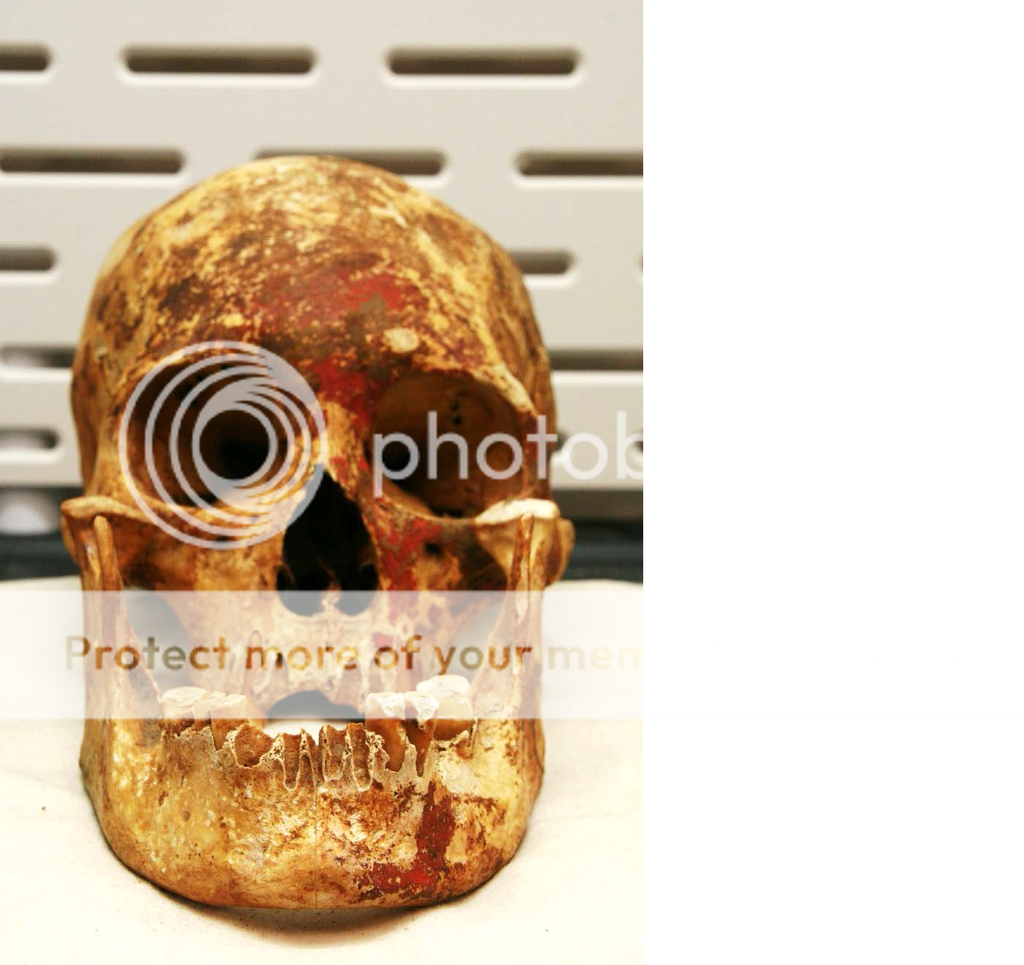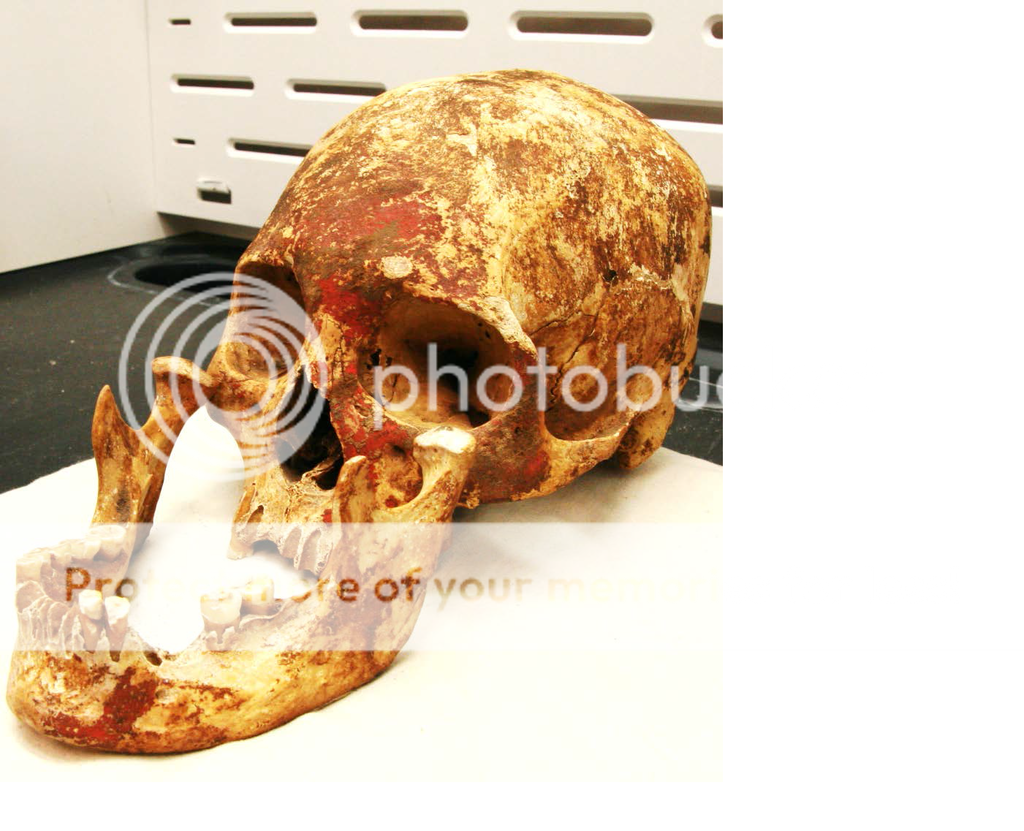It looks like you're using an Ad Blocker.
Please white-list or disable AboveTopSecret.com in your ad-blocking tool.
Thank you.
Some features of ATS will be disabled while you continue to use an ad-blocker.
share:
I found this on Austin Whitall's blog this morning,
Patagonian Monsters
That is very interesting Hg R0a1a, that is nearly basal R, which is a sister the Hg X, which is found in Kennewick man.
Though they are nearly 8,000 years apart it is fascinating that two "old world" haplogroups can be found in the plateau region.
Link To Paper
I'll add more when I get home from work
]I have just come across a very brief "Paper" which details a study conducted on a skull found in Idaho, U.S., which was dated by radiocarbon to an age of about 600-700 years BP and is therefore older than the arrival of Europeans (Columbus) to America. The startling finding is that: "Forensic Mitochondrial DNA Haplogroup R0a1a identified, although it is not associated with known Native American populations. Area where Haplogroup R0a1a originated is from the Arabian Peninsula or western Eurasia" [1] of course the authors find that rather difficult to explain so they added that: "Forensic mitochondrial DNA identified haplogroup R0a1a which originated on the Arabian Peninsula; this is not consistent with the rest of the data in the study. Future work will include. Additional trace element analysis from the bone to provide constraints to the duration of burial independent of C-14 dating. A secondary ancient DNA analysis to confirm or disprove the initial findings".
That is check if the skull is younger and therefore admixture with an Arabian could be more plausible or, the mtDNA was wrongly identified and therefore the skull is old and Amerindian.
The map shows where R0 hg is more prevalent: Middle East, Balkans, Horn of Africa and East AFrica....
Patagonian Monsters
That is very interesting Hg R0a1a, that is nearly basal R, which is a sister the Hg X, which is found in Kennewick man.
Though they are nearly 8,000 years apart it is fascinating that two "old world" haplogroups can be found in the plateau region.
Link To Paper
I'll add more when I get home from work
a reply to: punkinworks10
Columbus didn't "discover" America.
Lots of peoples were here before him.
a skull found in Idaho, U.S., which was dated by radiocarbon to an age of about 600-700 years BP and is therefore older than the arrival of Europeans (Columbus) to America.
Columbus didn't "discover" America.
Lots of peoples were here before him.
originally posted by: intrptr
a reply to: punkinworks10
a skull found in Idaho, U.S., which was dated by radiocarbon to an age of about 600-700 years BP and is therefore older than the arrival of Europeans (Columbus) to America.
Columbus didn't "discover" America.
Lots of peoples were here before him.
If a thing exists would you know it was there if it wasn't discovered?
originally posted by: highfromphoenix
originally posted by: intrptr
a reply to: punkinworks10
…a skull found in Idaho, U.S., which was dated by radiocarbon to an age of about 600-700 years BP and is therefore older than the arrival of Europeans (Columbus) to America.
Columbus didn't "discover" America.
Lots of peoples were here before him.
If a thing exists would you know it was there if it wasn't discovered?
The discovery thing goes with flag planting and claiming ownership for the King and all that. At least thats what they taught us in grade school… Everyone knows the date, too.
1492
The place didn't exist before it was "discovered".
But about this skull, what are the possibilities? Vikings were 'European' too, weren't they?
Back to it
a reply to: intrptr
No where did I , or the article say anything about Columbus discovering the Americas.
The Columbus reference was about the time period at which one would start to see introgression of European/Eurasian Haplogroups into the Americas.
And no Vikings would not have carried this haplogroup, in Europe it would be found among the early hunter/gatherers, or among people from Yemen/Ethiopia and the Balkans.
a reply to: intrptr
No where did I , or the article say anything about Columbus discovering the Americas.
The Columbus reference was about the time period at which one would start to see introgression of European/Eurasian Haplogroups into the Americas.
And no Vikings would not have carried this haplogroup, in Europe it would be found among the early hunter/gatherers, or among people from Yemen/Ethiopia and the Balkans.
a reply to: punkinworks10
Thanks for posting this. These finds always intrigue me as an archaeologist. Don't have time to read all of it right now but am replying to come back to it.
Thanks for posting this. These finds always intrigue me as an archaeologist. Don't have time to read all of it right now but am replying to come back to it.
a reply to: punkinworks10
I don't know enough about it to hold an intelligent conversation. Sorry for trolling.
in Europe it would be found among the early hunter/gatherers, or among people from Yemen/Ethiopia and the Balkans.
I don't know enough about it to hold an intelligent conversation. Sorry for trolling.
I don't have anything to support this but I'm going to start digging. I remember reading a theory that ancient Israelis are linked to copper mines up
in northern Wisconsin and the UP. I can't remember all the details, but if they were trying to connect various dots in the bible (or other books),
this may be a big piece of that puzzle.
Sorry for not having links, I can't remember if I read that here or somewhere else but I'll start digging and edit if I find something.
ETA: This seems close to what I read, but ill keep digging. Its not out west but if they were here there's no reason to think they wouldn't explore a bit.
King Solomon's Great Lake Mines
a reply to: punkinworks10
Sorry for not having links, I can't remember if I read that here or somewhere else but I'll start digging and edit if I find something.
ETA: This seems close to what I read, but ill keep digging. Its not out west but if they were here there's no reason to think they wouldn't explore a bit.
King Solomon's Great Lake Mines
a reply to: punkinworks10
edit on 15-7-2015 by DuckforcoveR because: (no reason given)
(post by Naabaahii removed for a serious terms and conditions violation)
And now for the juicy stuff


The skull is consistent with native American practices of head flattening, via a cradle board.
I would also like to point out that the skull also has a Neanderthal trait, the retro molar gap, it is the large gap behind the last lower molar.
Austin discusses retro molar gap here,
retro molar gap

The skull had traces of a red pigment on it, that has been identified as Cinnabar.
That fact is very interesting, as far a I know there is only one surface source for cinnabar ,in the continental US, and that is the New Idra mine in Fresno county ca.
It was the largest mercury in the world for several decades. I'm quite familiar with the place, actually I'm going through there this weekend.
Anyway that shows trade from Ca to the Columbia plateau.
Hair samples were also collected,

We can rule out cattle, musk ox, it could be mountain goat , or big horn sheep or dog.

His O isotope ratios show that he was born in a different place from where he lived most of his life.


Provenance, a history of ownership, helps provide contextual evidence of an item’s origin, or provenience. A transdisciplinary collaboration utilized a variety of techniques including archaeological and anthropological assessments, scanning electron microscopy (SEM), energy dispersive x-ray spectrometry (EDS), x-ray fluorescence (XRF), laser ablation inductively coupled plasma quadrapole mass spectrometry (LA-ICP-QMS), stable isotope analysis, radiocarbon dating and DNA analysis to yield information about the skull’s background. Researchers hope to obtain enough information in order to repatriate the individual’s remains.
The skull is consistent with native American practices of head flattening, via a cradle board.
I would also like to point out that the skull also has a Neanderthal trait, the retro molar gap, it is the large gap behind the last lower molar.
Austin discusses retro molar gap here,
retro molar gap

The skull had traces of a red pigment on it, that has been identified as Cinnabar.
That fact is very interesting, as far a I know there is only one surface source for cinnabar ,in the continental US, and that is the New Idra mine in Fresno county ca.
It was the largest mercury in the world for several decades. I'm quite familiar with the place, actually I'm going through there this weekend.
Anyway that shows trade from Ca to the Columbia plateau.
Hair samples were also collected,

Hair samples (top) match the consistency of human hair Animal fibers (bottom) most likely sheep’s wool or fine strands of cattle, deer, dog, goat, marmot or musk ox
We can rule out cattle, musk ox, it could be mountain goat , or big horn sheep or dog.

dating the skull to 1330-1400 AD Forensic Mitochondrial DNA Haplogroup R0a1a identified, although it is not associated with known Native American populations Area where Haplogroup R0a1a originated is from the Arabian Peninsula or western Eurasia
His O isotope ratios show that he was born in a different place from where he lived most of his life.
edit on 15-7-2015 by punkinworks10 because: (no reason given)
may have been the wrong way to word it. "people from the land that was then (and now) known as Israel"? David and Solomon's people? Is that better for
you? Or would you prefer ancient Canaanites? Or are we hung up on the word ancient? I can use "old ass" if it would make you feel better.
a reply to: Aliensun
a reply to: Aliensun
edit on 15-7-2015 by DuckforcoveR because: (no reason given)
a reply to: DuckforcoveR
Actually the use of copper in the great lakes region predates Solomon by more than 6000 years, and itvpredates copper use in the old world by 2000 years.
Actually the use of copper in the great lakes region predates Solomon by more than 6000 years, and itvpredates copper use in the old world by 2000 years.
a reply to: diggindirt
Hi diggindirt,
I appreciate input from the pros,
I wish there was more info about the site and it's context
Hi diggindirt,
I appreciate input from the pros,
I wish there was more info about the site and it's context
So now the big question is how this ancient west Eurasian haplogroup found its way to Idaho.
Is it representative of an ancient west eurasin component of the first people into the new world, and is connected with HG X, which is found among neighboring native American tribes ,like the Yakama and Chinook.
Or does it represents sent a later movement of people from Eurasia, like maybe bronze age people.
Is it representative of an ancient west eurasin component of the first people into the new world, and is connected with HG X, which is found among neighboring native American tribes ,like the Yakama and Chinook.
Or does it represents sent a later movement of people from Eurasia, like maybe bronze age people.
As I remember, copper ingots were recovered from a Roman shipwreck in the Mediterranean. When the isotopic ratios were measured, the best match for the source was the Upper Peninsula.
originally posted by: DuckforcoveR
I don't have anything to support this but I'm going to start digging. I remember reading a theory that ancient Israelis are linked to copper mines up in northern Wisconsin and the UP. I can't remember all the details, but if they were trying to connect various dots in the bible (or other books), this may be a big piece of that puzzle.
a reply to: punkinworks10
new topics
-
Watts home paranormal activity
Paranormal Studies: 1 hours ago -
So, what is really going on in South Korea ?
World War Three: 1 hours ago -
Congress Says the FBI is Covering Up Vital Info on the Jan 5th 2021 D.C. Pipe Bombs at RNC-DNC.
Political Conspiracies: 2 hours ago -
The trial on kids was stopped
Medical Issues & Conspiracies: 5 hours ago -
Orbs Appear And Form Triangle On Live Cam.
Aliens and UFOs: 7 hours ago -
Biden Has New Bizarre Injuries to His Face
Politicians & People: 8 hours ago -
Something is not adding up in regards to the H-1B commotion
General Conspiracies: 9 hours ago -
Elon Musk Calls for Tommy Robinson to be Freed - and Takes a Dig at Starmer
Politicians & People: 9 hours ago -
Biden to award Presidential Citizens Medal to Liz Cheney and Bennie Thompson
US Political Madness: 10 hours ago
top topics
-
Biden Has New Bizarre Injuries to His Face
Politicians & People: 8 hours ago, 11 flags -
Biden to award Presidential Citizens Medal to Liz Cheney and Bennie Thompson
US Political Madness: 10 hours ago, 9 flags -
The trial on kids was stopped
Medical Issues & Conspiracies: 5 hours ago, 9 flags -
Just learned a really helpful trick for internet searches
Computer Help: 15 hours ago, 7 flags -
Congress Says the FBI is Covering Up Vital Info on the Jan 5th 2021 D.C. Pipe Bombs at RNC-DNC.
Political Conspiracies: 2 hours ago, 7 flags -
Orbs Appear And Form Triangle On Live Cam.
Aliens and UFOs: 7 hours ago, 6 flags -
Not off to a good start
General Chit Chat: 17 hours ago, 6 flags -
Something is not adding up in regards to the H-1B commotion
General Conspiracies: 9 hours ago, 5 flags -
Elon Musk Calls for Tommy Robinson to be Freed - and Takes a Dig at Starmer
Politicians & People: 9 hours ago, 5 flags -
So, what is really going on in South Korea ?
World War Three: 1 hours ago, 4 flags
active topics
-
-@TH3WH17ERABB17- -Q- ---TIME TO SHOW THE WORLD--- -Part- --44--
Dissecting Disinformation • 3902 • : duncanagain -
Tesla Cybertruck Explodes in Front of Trump Hotel in Las Vegas
Mainstream News • 131 • : TheMisguidedAngel -
The C.D.C. Says There Was NO INFLUENZA Worth Reporting for the 2020-2021 Flu Season.
Diseases and Pandemics • 97 • : fos613 -
The trial on kids was stopped
Medical Issues & Conspiracies • 8 • : fos613 -
Mood Music Part VI
Music • 3775 • : Skinnerbot -
Congress Says the FBI is Covering Up Vital Info on the Jan 5th 2021 D.C. Pipe Bombs at RNC-DNC.
Political Conspiracies • 16 • : WeMustCare -
Something is not adding up in regards to the H-1B commotion
General Conspiracies • 27 • : fringeofthefringe -
Vehicle Strikes people in New Orleans
Mainstream News • 283 • : WeMustCare -
Watts home paranormal activity
Paranormal Studies • 3 • : TheMisguidedAngel -
Post A Funny (T&C Friendly) Pic Part IV: The LOL awakens!
General Chit Chat • 7980 • : underpass61
